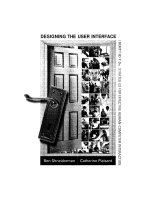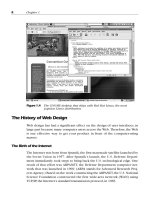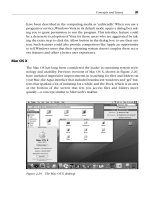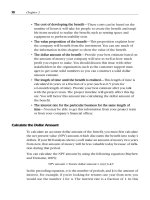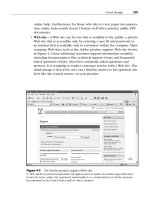jQuery UI 1.6 The User Interface Library for jQuery potx
Bạn đang xem bản rút gọn của tài liệu. Xem và tải ngay bản đầy đủ của tài liệu tại đây (7.72 MB, 437 trang )
jQuery UI 1.6
The User Interface Library for jQuery
Build highly interactive web applications with
ready-to-use widgets from the jQuery user
interface library
Dan Wellman
BIRMINGHAM - MUMBAI
jQuery UI 1.6
The User Interface Library for jQuery
Copyright © 2009 Packt Publishing
All rights reserved. No part of this book may be reproduced, stored in a retrieval
system, or transmitted in any form or by any means, without the prior written
permission of the publisher, except in the case of brief quotations embedded in
critical articles or reviews.
Every effort has been made in the preparation of this book to ensure the accuracy of
the information presented. However, the information contained in this book is sold
without warranty, either express or implied. Neither the author, Packt Publishing,
nor its dealers or distributors will be held liable for any damages caused or alleged
to be caused directly or indirectly by this book.
Packt Publishing has endeavored to provide trademark information about all the
companies and products mentioned in this book by the appropriate use of capitals.
However, Packt Publishing cannot guarantee the accuracy of this information.
First published: January 2009
Production Reference: 1200109
Published by Packt Publishing Ltd.
32 Lincoln Road
Olton
Birmingham, B27 6PA, UK.
ISBN 978-1-847195-12-8
www.packtpub.com
Cover Image by Karl Swedberg ()
Credits
Author
Dan Wellman
Reviewers
Akash Mehta
David Methvin
Mark Grabanski
Senior Acquisition Editor
Douglas Paterson
Development Editor
Ved Prakash Jha
Technical Editor
Dhiraj Bellani
Editorial Team Leader
Akshara Aware
Production Editorial Manager
Abhijeet Deobhakta
Projects Team Leader
Lata Basantani
Project Coordinators
Neelkanth Mehta
Brinell Lewis
Indexer
Hemangini Bari
Proofreaders
Joel Johnson
Camille Guy
Production Coordinator
Aparna Bhagat
Cover Work
Aparna Bhagat
About the Author
Dan Wellman lives with his wife and children in his home town of Southampton
on the south coast of England. By day, his mild-mannered alter-ego works for a
small, yet accomplished, e-commerce production agency. By night, he battles the
forces of darkness and ghts for truth, justice, and less intrusive JavaScript.
Dan has been writing computer-related articles, tutorials, and reviews for around
ve years and is rarely very far from a keyboard of some description.
This is his second book.
I'd like to say a big, personal thank you to the Packt editorial
team for their continued support and encouragement, and to the
jQuery UI development team for producing such an incredible
library. Special thanks also goes out to Eamon O'Donoghue for his
invaluable graphic/imagery advice, and to Mike Newth for his
equally invaluable printing assistance. Finally, I'd like to thank James
Zabiela, Andrew Herman, Steve Bishop, Aaron Matheson, Dan
Goodall, Mike Woodford, and John Adams; they contributed in no
way towards this book, but are nevertheless the greatest bunch of
dudes a guy could hang out with.
About the Reviewers
Akash Mehta is a web application developer, technical writer, and business
consultant based in Brisbane, Australia. His past projects include brochure websites,
e-learning solutions, and information systems. He has written web development
articles for several publishers in print and online. He is a regular speaker at local
conferences, and contributes to prominent PHP blogs.
As a student, Akash maintained PHP web applications and built user interfaces
using the jQuery toolkit. While pursuing both a commerce and an IT degree, Akash
develops web applications on PHP and Python platforms. After hours, he organizes
his local PHP user group.
Akash develops applications on a wide range of open source libraries. His toolbox
includes a number of application frameworks, including the Zend Framework,
CakePHP, and Django; Javascript frameworks, including jQuery, Prototype and
Mootools; platforms such as Adobe Flash/Flex; and the MySQL and SQLite
database engines.
Currently, Akash provides freelance technical writing and web development
through his website, .
David Methvin is the Chief Technology Ofcer at PC Pitstop, and one of the
founding partners of the company. He provides technical direction for the
www.pcpitstop.com website, oversees software development, and serves as an
editor for the site's content. David also serves as the site's chief investigator for new
spyware and adware threats. Before joining PC Pitstop, David had an extensive
career in computer journalism. He served as an Executive Editor at both Windows
Magazine and PC Tech Journal, co-authored a book on Windows NT networking,
and wrote articles for more than two dozen publications. David continues to write
a monthly column, "The Well-Tuned PC," for pctoday.com magazine. David holds
both Bachelor's and Master's Degrees in Computer Science from the University of
Virginia. After graduation, he spent several years designing and developing
software for robotics and telecommunications systems with companies such as
General Electric.
Marc Grabanski runs a consulting company focused on user interface
development and user experience. He believes rmly that open source is the fuel
that helps a developer go from mediocre to excellent at what they do. His work with
jQuery was no exception. By writing jQuery UI Datepicker, he met so many great
people and is thankful for the experiences gained by doing this project.
I want to thank, of course, John Resig for writing jQuery and
the whole jQuery UI team for carrying the library to new levels
each day.
This book is dedicated to my supportive and understanding wife Tammy.
Thanks babe.
Table of Contents
Preface 1
Chapter 1: Introducing jQuery UI 9
Is this book for me? 10
Downloading the library 11
Setting up a development environment 12
The structure of the library 13
Unit testing 14
Widget theming 15
Minified and packed components 15
Theme Roller 16
The simplified API 17
Component categories 18
Browser support 19
Book examples 20
Library licensing 21
Summary 21
Chapter 2: Tabs 23
A basic tab implementation 24
Tab styling 26
Configurable properties 28
Transition effects 31
Tab events 33
Using tab methods 37
Enabling and disabling tabs 37
Adding and removing tabs 39
Simulating clicks 42
Creating a tab carousel 43
AJAX tabs 46
Table of Contents
[ ii ]
Fun with tabs 52
Summary 56
Chapter 3: The Accordion Widget 57
Accordion's structure 58
Styling the accordion 61
Configuring accordion 65
Accordion methodology 72
Destruction 72
Enabling and disabling 74
Drawer activation 78
Accordion animation 79
Accordion events 81
Fun with accordion 83
Summary 87
Chapter 4: The Dialog 89
A basic dialog 90
Custom dialog skins 92
Dialog properties 94
Adding buttons 98
Working with dialog's callbacks 100
Using dialog animations 102
Controlling a dialog programmatically 104
Getting data from the dialog 108
Fun with dialog 111
Summary 116
Chapter 5: Slider 117
Implementing slider 118
Overriding the default theme 119
Configurable properties 122
Using slider's callback functions 125
Slider methods 127
Slider animation 131
Multiple handles 131
Fun with slider 134
Summary 138
Chapter 6: Date Picker 139
The default date picker 140
Skinning the date picker 142
Configurable properties of the picker 144
Changing the date format 148
Table of Contents
[ iii ]
Localization 150
Callback properties 156
Trigger buttons 159
Multiple months 161
Enabling range selection 163
Configuring alternative animations 164
Date picking methods 166
Putting the date picker in a dialog 168
Fun with date picker 175
Summary 182
Chapter 7: Auto-Complete 183
Basic implementation 184
Configurable properties 186
Scrolling 190
Auto-complete styling 192
Multiple selections 197
Advanced formatting 198
Matching properties 205
Remote data 207
Sending additional data to the server 210
Caching 210
Auto-complete methods 211
Fun with auto-complete 214
Summary 218
Chapter 8: Drag and Drop 219
The deal with drag and droppables 220
Draggables 221
A basic drag implementation 221
Configuring draggable properties 223
Resetting dragged elements 227
Drag handles 228
Helper elements 230
Constraining the drag 233
Snapping 236
Draggable event callbacks 238
Using draggable's methods 243
Droppables 244
Configuring droppables 247
Tolerance 251
Droppable event callbacks 254
Greed 257
Table of Contents
[ iv ]
Droppable methods 261
Fun with droppables 261
Summary 267
Chapter 9: Resizing 269
A basic resizable 270
Skinning the resizable 273
Resizable properties 274
Configuring resize handles 275
Defining size limits 279
Resize ghosts 280
Constraining the resize and maintaining ratio 282
Resizable animations 284
Resizable callbacks 286
Resizable methods 289
Fun with resizable 289
Summary 292
Chapter 10: Selecting 293
Basic implementation 294
Selectee class names 297
Configurable properties of the selectable class 298
Filtering selectables 299
Selectable callbacks 301
Selectable methods 304
Fun with selectables 308
Summary 320
Chapter 11: Sorting 321
Basic implementation 321
Configuring sortable properties 325
Placeholders 331
Sortable helpers 334
Sortable items 336
Connected lists 338
Reacting to sortable events 341
Connected callbacks 347
Sortable methods 351
Widget compatibility 354
Fun with sortable 356
The main script 360
Summary 373
Table of Contents
[ v ]
Chapter 12: UI Effects 375
The core effects file 376
Color animations 376
Class transitions 378
Advanced easing 380
Highlighting 381
Additional effect parameters 382
Bouncing 384
Shaking 385
Transference 387
Scaling 390
Element explosion 392
The puff effect 395
Pulsate 397
Drop 399
Slide 402
Clip 405
Blind 407
Fold 409
Summary 411
Index 413
Preface
jQuery has been a phenomenal success, with many newcomers to the world of
JavaScript frameworks choosing it, and many developers moving to it from other
frameworks. jQuery UI is tipped to follow suit, and has already seen massive growth
and take-up, with more success to follow. By learning how to use it now, you can be
a part of its success.
jQuery UI is a collection of engaging widgets and essential interaction-helpers that
can help drastically reduce the amount of code you need to write and the amount
of time you need to spend developing. Each component comes with a wide range
of easy-to-use congurable properties and methods. The components all share a
common programming interface that quickly becomes second nature to work with.
Development of the library is ongoing, with highly-skilled developers building it to
ever greater levels. New components are being added between major releases, and
bug xes/updates are constantly being tested and applied. jQuery UI is very much a
community-driven site, with the team relying on and building upon bug reports and
feature requests submitted by the wider development community. Additionally, new
components are often derived from the most useful jQuery plug-ins.
This book will give you a head start in learning jQuery UI; exposing the APIs behind
the complete range of components as of version 1.5.4, and including much of the
functionality of version 1.6 of the library. Each component is methodically and
consistently looked at, with many functional examples. Each chapter ends with a full
implementational example, looking at ways in which the components can be used in
real-world scenarios.
Preface
[ 2 ]
What this book covers
Chapter 1 A general overview of jQuery UI. You'll nd out exactly what the
library is, where it can be downloaded from and where resources for it can be
found. You'll look at the freedom the license gives you to use the library, and how
the API has been simplied to give the components a consistent and easy-to-use
programming model.
Chapter 2 We begin our journey through jQuery UI by looking at the high-level user
interface widgets, focusing on the tabs component; a simple but effective means of
presenting structured content in an engaging and interactive widget.
Chapter 3 Next, we take a look at the accordion widget. This is another component
dedicated to the effective display of content. Highly engaging and interactive, the
accordion makes a valued addition to any web page and its API is exposed in full
to show exactly how it can be used.
Chapter 4 In this chapter, we focus on the dialog widget. The dialog behaves in the
same way as a standard browser alert, but it does so in a much less intrusive and
visitor-friendly manner. We look at how it can be congured and controlled to
provide maximum benet and appeal.
Chapter 5 The slider widget provides a less commonly used, but no less valued,
user interface tool for collecting input from your visitors. We look closely at its API
throughout this chapter to see the variety of ways in which it can be implemented.
Chapter 6 Next, we look at the date picker. This component packs a huge amount
of functionality and appeal into an attractive and highly usable tool allowing your
visitors to effortlessly select dates. We look at the wide range of congurations that
its API makes possible as well as seeing how easy common tasks, such as skinning
and localization, are made.
Chapter 7 The last widget we look at is the auto-complete; a highly professional and
desired addition to any page. We'll look at the different data sources you can provide
and how to customize the widget, in addition to seeing which properties and
methods we have at our disposal. At the time of writing, the latest stable version of
the UI library is 1.5.4, but this widget is part of 1.6 release, a sneak preview of what
we've got to look forward to.
Chapter 8 We begin looking at the low-level interaction helpers in this chapter,
tackling rst the related draggable and droppable components. We look at how
they can be implemented individually and how they can be used together for
maximum effect.
Preface
[ 3 ]
Chapter 9 In this chapter, we look at resizing component and see how it is used with
the dialog widget. We see how it can be applied to any element on the page to allow
it to be resized in a smooth and attractive way.
Chapter 10 Next, we look at the selectable component, which allows us to add
behavior to elements on the page and allow them to be selected individually or as
a group. We see that this is one component that really brings the desktop and the
browser together as application platforms.
Chapter 11 We look at the nal interaction helper in this chapter – the sortable
component. This is an especially effective component that allows you to create lists
on a page that can be reordered by dragging items to a new position on the list. This
is another component that can really help you to add a high level of professionalism
and interactivity to your site with a minimum of effort.
Chapter 12 The last chapter of the book is dedicated solely to the special effects that
are included with the library. We look at an array of different effects that allow you
to show, hide, move, and jiggle elements in a variety of attractive and appealing
animations. There is no 'fun with' section at the end of this chapter; the whole
chapter is a 'fun with' section.
What you need for this book
Very little is required in order to start using jQuery UI. Specically, you will need the
following environment:
A text editor; be it Notepad, or a full-blown development application
like Dreamweaver
A browser
A copy of jQuery and a copy of jQuery UI
An internet connection for dynamic data retrieval in some of the examples
Who is this book for
This book is for front-end designers and developers who need to quickly learn how
to use the jQuery UI User Interface Library. To get the most out of this book, you
should have a good working knowledge of HTML, CSS, and JavaScript, and will
need to be comfortable using jQuery, the underlying foundation of jQuery UI.
•
•
•
•
Preface
[ 4 ]
Conventions
In this book, you will nd a number of styles of text that distinguish between
different kinds of information. Here are some examples of these styles, and an
explanation of their meaning.
Code words in text are shown as follows: "It is easy to achieve this by manipulating
the disabled property of the tabs."
A block of code will be set as follows:
<!DOCTYPE HTML PUBLIC "-//W3C//DTD HTML 4.01//EN" " />TR/html4/strict.dtd">
<html lang="en">
<head>
<link rel="stylesheet" type="text/css" href="jqueryui1.6rc2/
themes/flora/flora.tabs.css">
<link rel="stylesheet" type="text/css" href="styles/
tabsTheme.css">
<meta http-equiv="Content-Type" content="text/html;
charset=utf-8">
<title>jQuery UI Tabs Example 3</title>
</head>
<body>
<ul id="myTabs">
<li><a href="#0"><span>Tab 1</span></a></li>
<li><a href="#1"><span>Tab 2</span></a></li>
</ul>
<div id="0">This is the content panel linked to the first tab, it
is shown by default.</div>
<div id="1">This content is linked to the second tab and will be
shown when its tab is clicked.</div>
<script type="text/javascript" src="jqueryui1.6rc2/
jquery-1.2.6.js"></script>
<script type="text/javascript" src="jqueryui1.6rc2/ui/
ui.core.js"></script>
<script type="text/javascript" src="jqueryui1.6rc2/ui/
ui.tabs.js"></script>
<script type="text/javascript">
//define function to be executed on document ready
$(function(){
//define config object
var tabOpts = {
selected: 1
};
//create the tabs
$("#myTabs").tabs(tabOpts);
Preface
[ 5 ]
});
</script>
</body>
</html>
When we wish to draw your attention to a particular part of a code block, the
relevant lines or items will be made bold:
<!DOCTYPE HTML PUBLIC "-//W3C//DTD HTML 4.01//EN" " />TR/html4/strict.dtd">
<html lang="en">
<head>
<link rel="stylesheet" type="text/css" href="jqueryui1.6rc2/
themes/flora/flora.tabs.css">
<link rel="stylesheet" type="text/css" href="styles/
tabsTheme.css">
<meta http-equiv="Content-Type" content="text/html;
charset=utf-8">
<title>jQuery UI Tabs Example 4</title>
</head>
<body>
<ul id="myTabs">
<li><a href="#0"><span>Tab 1</span></a></li>
<li><a href="#1"><span>Tab 2</span></a></li>
</ul>
<div id="0">This is the content panel linked to the first tab, it
is shown by default.</div>
<div id="1">This content is linked to the second tab and will be
shown when its tab is clicked.</div>
<script type="text/javascript" src="jqueryui1.6rc2/
jquery-1.2.6.js"></script>
<script type="text/javascript" src="jqueryui1.6rc2/ui/
ui.core.js"></script>
<script type="text/javascript" src="jqueryui1.6rc2/ui/
ui.tabs.js"></script>
<script type="text/javascript">
//define function to be executed on document ready
$(function(){
//define config object
var tabOpts = {
selected: 1,
disabled: [0]
};
//create the tabs
$("#myTabs").tabs(tabOpts);
});
</script>
</body>
</html>
Preface
[ 6 ]
New terms and important words are introduced in a bold-type font. Words that you
see on the screen, in menus or dialog boxes for example, appear in our text like this:
"Another problem we have with our test page is that clicking the Enable! button
while the accordion is already enabled does nothing."
Warnings or important notes appear in a box like this.
Tips and tricks appear like this.
Reader feedback
Feedback from our readers is always welcome. Let us know what you think about
this book, what you liked or may have disliked. Reader feedback is important for us
to develop titles that you really get the most out of.
To send us general feedback, simply drop an email to ,
making sure to mention the book title in the subject of your message.
If there is a book that you need and would like to see us publish, please send
us a note in the SUGGEST A TITLE form on www.packtpub.com or email
If there is a topic that you have expertise in and you are interested in either writing
or contributing to a book, see our author guide on www.packtpub.com/authors.
Customer support
Now that you are the proud owner of a Packt book, we have a number of things to
help you to get the most from your purchase.
Downloading the example code for the book
Visit to directly
download the example code.
The downloadable les contain instructions on how to use them.
Preface
[ 7 ]
Errata
Although we have taken every care to ensure the accuracy of our contents, mistakes
do happen. If you nd a mistake in one of our books—maybe a mistake in text or
code—we would be grateful if you would report this to us. By doing this you can
save other readers from frustration, and help to improve subsequent versions of
this book. If you nd any errata, report them by visiting ktpub.
com/support, selecting your book, clicking on the let us know link, and entering
the details of your errata. Once your errata are veried, your submission will be
accepted and the errata added to the list of existing errata. The existing errata can
be viewed by selecting your title from />Piracy
Piracy of copyright material on the Internet is an ongoing problem across all
media. At Packt, we take the protection of our copyright and licenses very seriously.
If you come across any illegal copies of our works in any form on the Internet,
please provide the location address or website name immediately so we can
pursue a remedy.
Please contact us at with a link to the suspected
pirated material.
We appreciate your help in protecting our authors, and our ability to bring you
valuable content.
Questions
You can contact us at if you are having a problem with
some aspect of the book, and we will do our best to address it.

